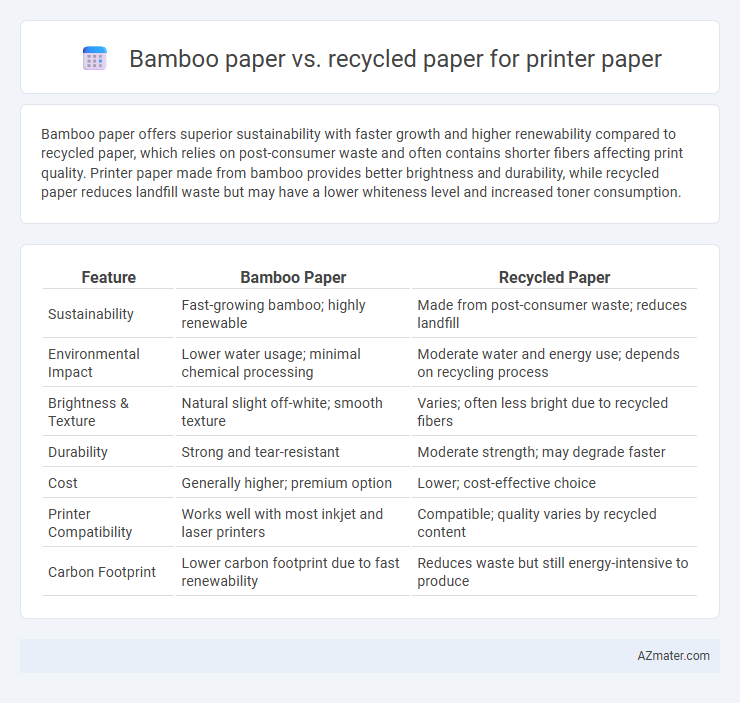Bamboo paper offers superior sustainability with faster growth and higher renewability compared to recycled paper, which relies on post-consumer waste and often contains shorter fibers affecting print quality. Printer paper made from bamboo provides better brightness and durability, while recycled paper reduces landfill waste but may have a lower whiteness level and increased toner consumption.
Table of Comparison
| Feature | Bamboo Paper | Recycled Paper |
|---|---|---|
| Sustainability | Fast-growing bamboo; highly renewable | Made from post-consumer waste; reduces landfill |
| Environmental Impact | Lower water usage; minimal chemical processing | Moderate water and energy use; depends on recycling process |
| Brightness & Texture | Natural slight off-white; smooth texture | Varies; often less bright due to recycled fibers |
| Durability | Strong and tear-resistant | Moderate strength; may degrade faster |
| Cost | Generally higher; premium option | Lower; cost-effective choice |
| Printer Compatibility | Works well with most inkjet and laser printers | Compatible; quality varies by recycled content |
| Carbon Footprint | Lower carbon footprint due to fast renewability | Reduces waste but still energy-intensive to produce |
Introduction to Sustainable Printer Paper Options
Bamboo paper offers a sustainable alternative to traditional printer paper by utilizing fast-growing bamboo fibers, which reduce deforestation and require less water during production. Recycled paper, made from post-consumer waste, minimizes landfill impact and lowers energy consumption compared to virgin paper manufacturing. Both options support eco-friendly printing solutions, contributing to reduced carbon footprints and resource conservation in office environments.
Bamboo Paper: Production Process and Features
Bamboo paper for printers is produced by harvesting fast-growing bamboo stalks, which are then processed into pulp without the heavy use of chemicals, resulting in a more eco-friendly and sustainable manufacturing method compared to traditional wood-based recycled paper. This production process preserves the natural fibers of bamboo, creating a durable, smooth, and bright printing surface that enhances print quality. Bamboo paper is naturally antibacterial and resistant to tearing, making it ideal for high-volume printing while supporting reduced deforestation and lower carbon emissions.
Recycled Paper: Composition and Manufacturing
Recycled paper for printers is primarily composed of post-consumer waste fibers derived from used paper products, reducing demand on virgin materials and minimizing environmental impact. The manufacturing process involves collecting, sorting, and deinking paper waste, followed by pulping, cleaning, and reforming into new sheets that meet quality standards for printing. This process conserves energy and water compared to traditional paper production, making recycled paper an eco-friendly alternative with a lower carbon footprint.
Environmental Impact: Bamboo vs Recycled Paper
Bamboo paper offers a faster renewable resource with a growth cycle of 3-5 years compared to the uncertain sourcing and variable quality of recycled paper. It requires fewer pesticides and less water, resulting in a lower carbon footprint and less deforestation. Recycled paper reduces landfill waste and consumes less energy than virgin paper production, but may still involve chemical treatments that impact the environment.
Print Quality and Performance Comparison
Bamboo paper offers superior print quality with smoother texture and less ink absorption, resulting in sharper, more vibrant prints compared to recycled paper. Recycled paper often contains fibers that can cause inconsistent ink distribution, leading to smudging and lower image clarity. The performance of bamboo paper exceeds recycled paper in printer reliability, reducing jams and wear on printer components due to its uniform fiber composition and higher durability.
Cost Analysis: Bamboo Paper vs Recycled Paper
Bamboo paper generally costs more than recycled paper due to the sustainable harvesting and processing methods involved in bamboo cultivation. Recycled paper benefits from lower production expenses by repurposing existing paper fibers, making it a more economical option for high-volume printing needs. Cost analysis reveals that businesses prioritizing budget-friendly printer paper often prefer recycled paper, while bamboo paper appeals to those willing to invest in eco-friendly materials despite higher prices.
Availability and Market Trends
Bamboo paper is gaining traction in the printer paper market due to its sustainable sourcing and faster growth rate compared to traditional recycled paper, which remains widely available but faces supply fluctuations from varying recycling rates. Market trends indicate a rising consumer preference for bamboo paper driven by its eco-friendly attributes and durability, with major manufacturers increasingly incorporating bamboo fibers in their product lines. Recycled paper continues to dominate in terms of availability and cost-effectiveness, but the expansion of bamboo paper reflects a shift toward more sustainable alternatives in office and commercial printing sectors.
Certifications and Eco-labels to Consider
Bamboo paper often carries certifications like FSC (Forest Stewardship Council) and PEFC (Programme for the Endorsement of Forest Certification), ensuring sustainable harvesting and responsible forest management, while recycled paper typically features the EPA's Recycled Content Label or Green Seal certification, indicating high post-consumer waste content and low environmental impact. Eco-labels such as the Blue Angel and EU Ecolabel are common for both, verifying reduced chemical use and energy-efficient production processes. Choosing printer paper with these certifications and eco-labels guarantees environmental accountability and supports sustainable forestry and waste reduction initiatives.
Pros and Cons of Bamboo Printer Paper
Bamboo printer paper offers exceptional sustainability due to bamboo's rapid growth rate and minimal use of pesticides, making it an eco-friendly alternative to traditional wood pulp paper. It tends to be stronger and more durable, reducing paper jams and improving print quality, though it may be slightly more expensive than recycled paper. One downside is that bamboo paper recycling infrastructure is less developed, potentially limiting its full environmental benefits compared to widely accepted recycled paper options.
Pros and Cons of Recycled Printer Paper
Recycled printer paper reduces environmental impact by minimizing deforestation and conserving energy during production, contributing to sustainability goals. However, it can sometimes have lower brightness and produce more dust, potentially affecting print quality and printer maintenance. Despite these drawbacks, recycled paper remains a cost-effective and eco-friendly choice for everyday printing needs.

Infographic: Bamboo paper vs Recycled paper for Printer paper
 azmater.com
azmater.com